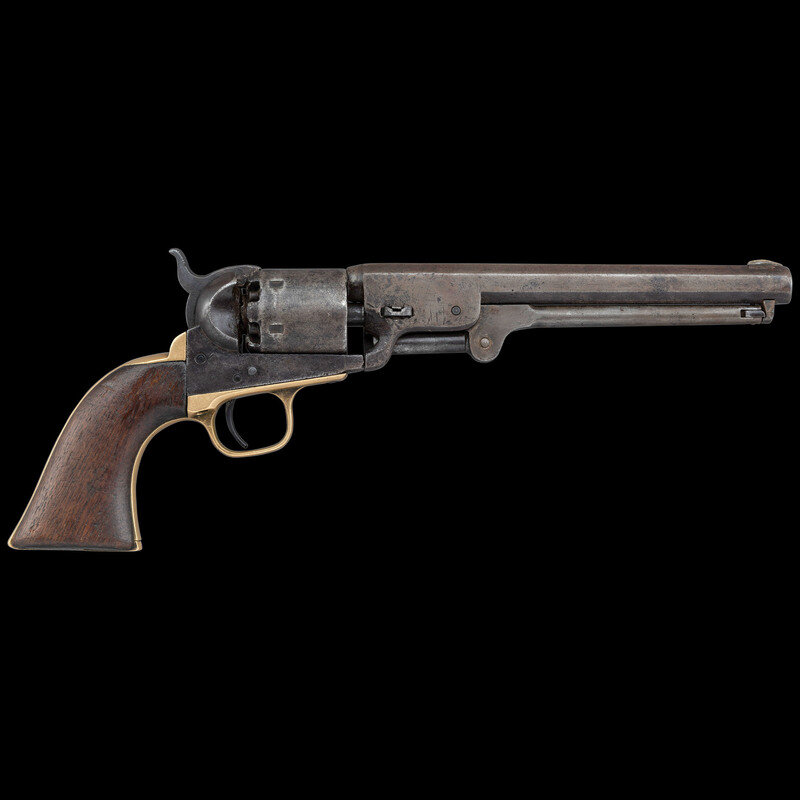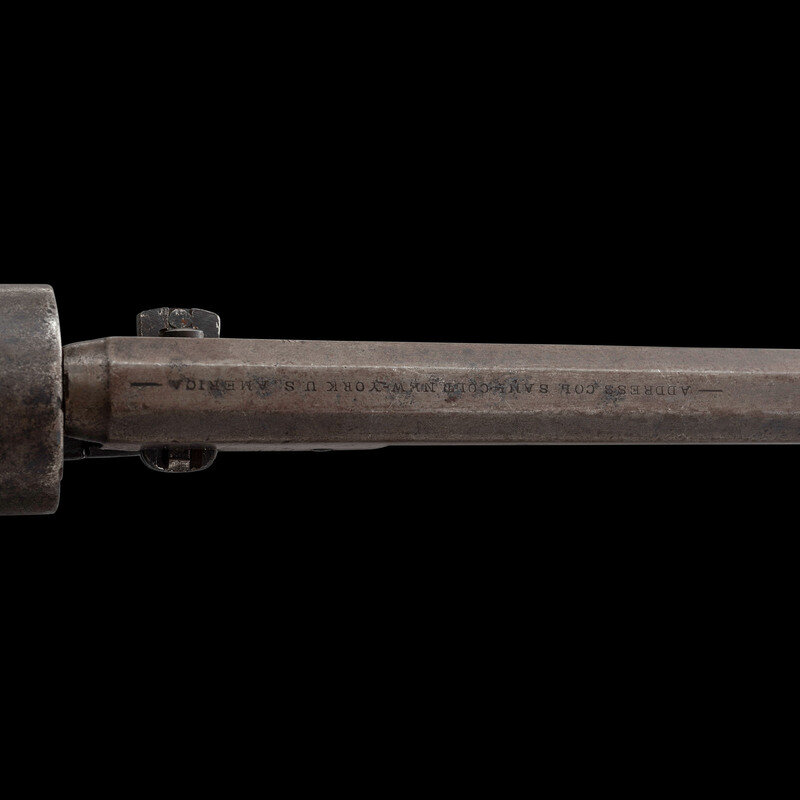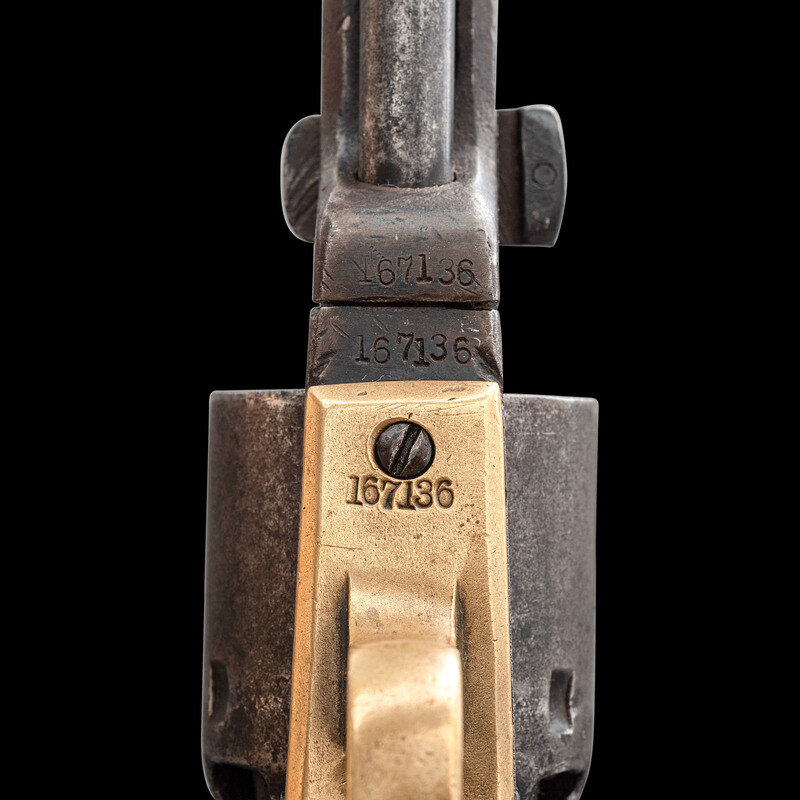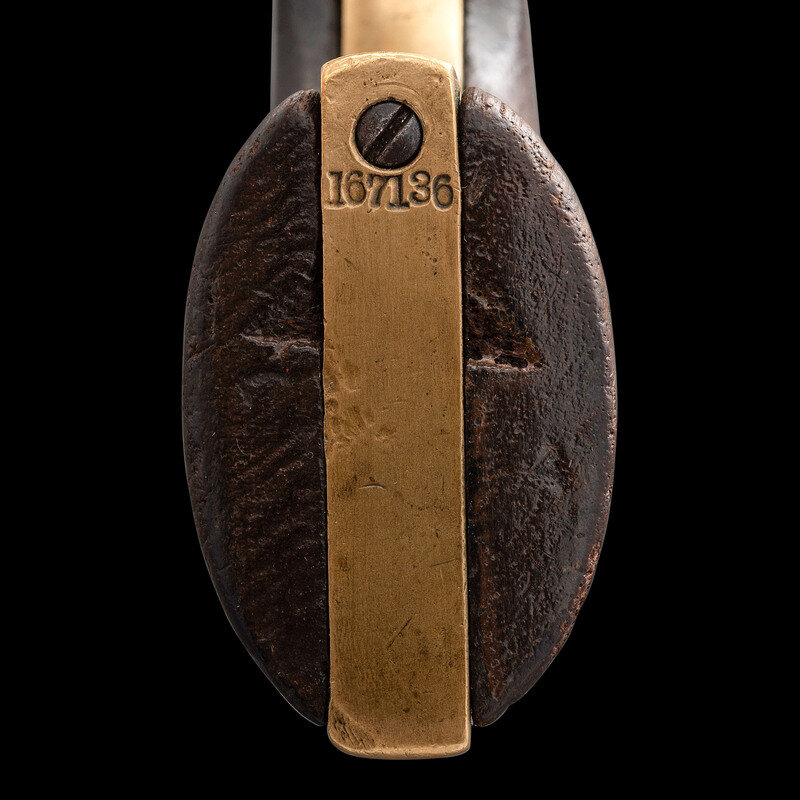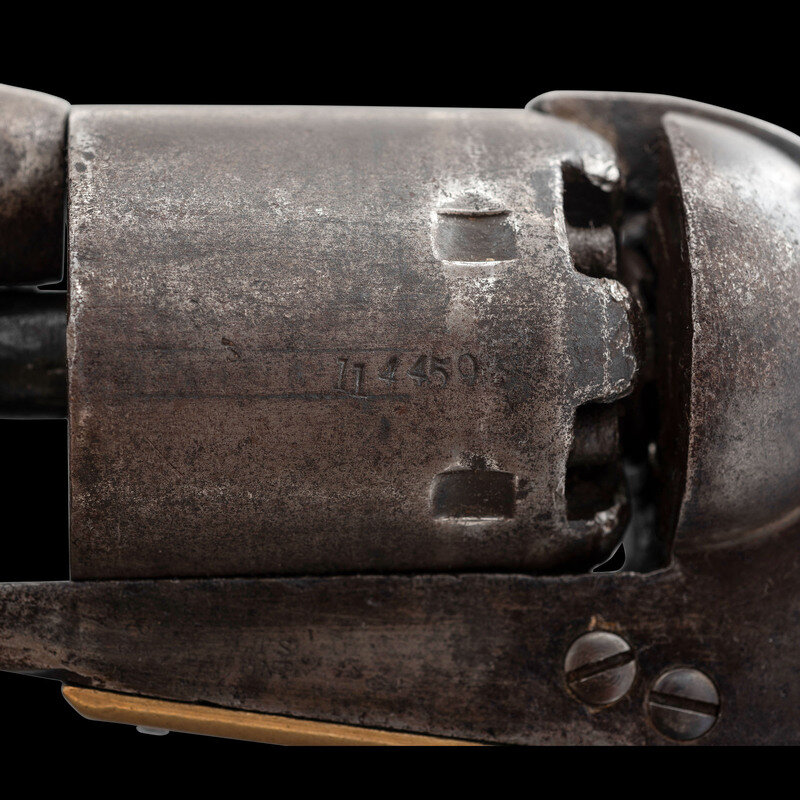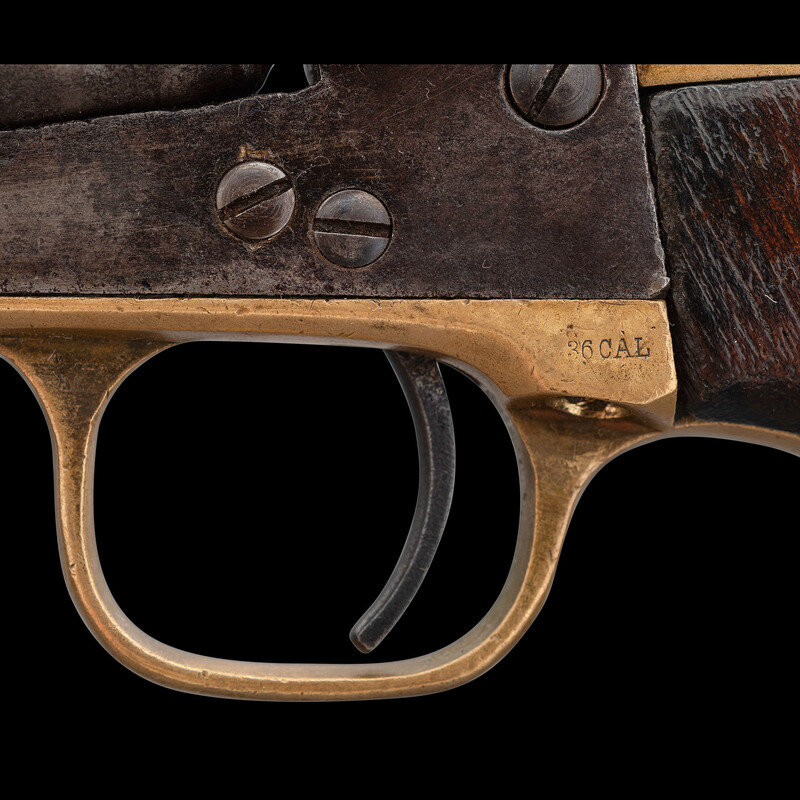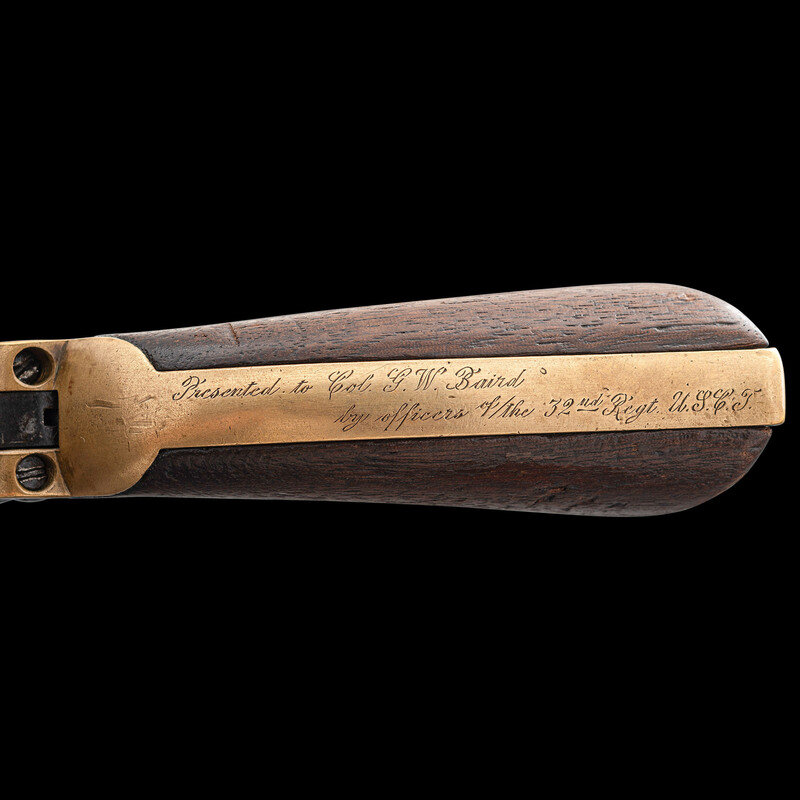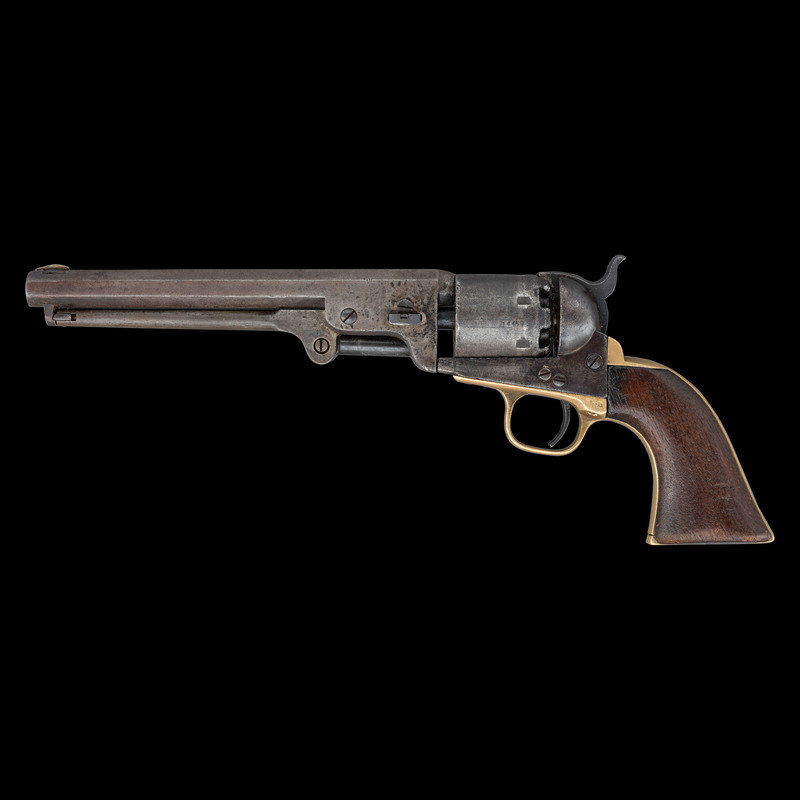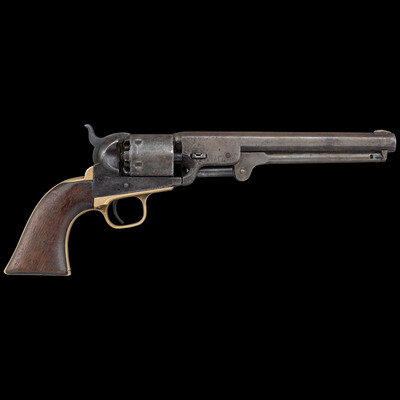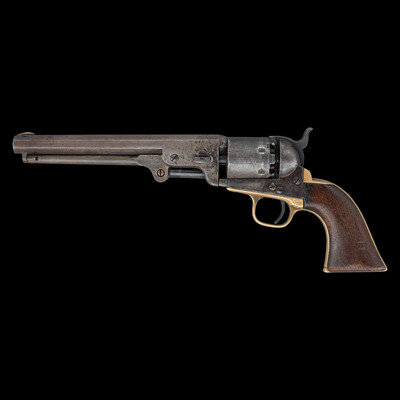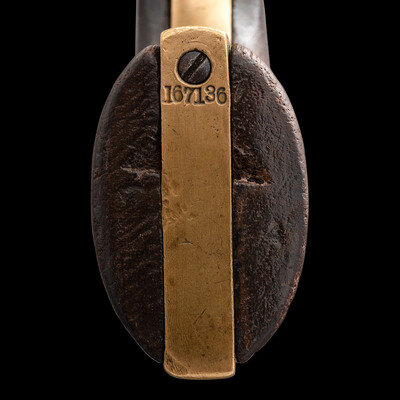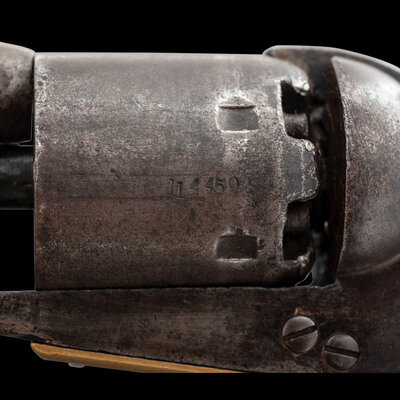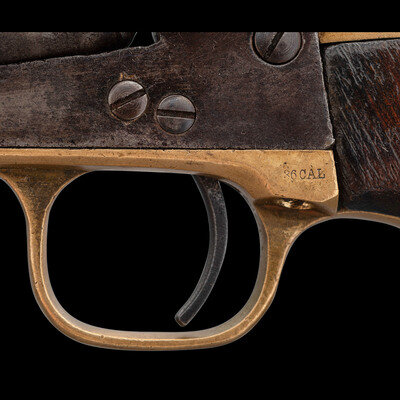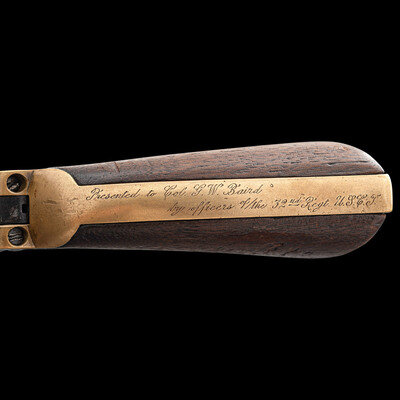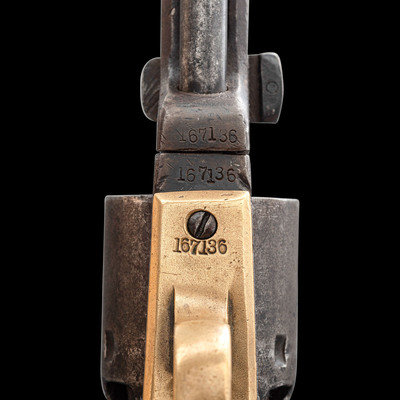.36 caliber. 7.5" octagonal barrel. SN: 167136 (mfg. ca.1863). Originally blued and color casehardened with no finish remaining, brass backstrap and triggerguard, one-piece walnut grip. Single action percussion revolver with six-chambered round cylinder. The barrel is marked with a single line address that reads: - ADDRESS COL SAML COLT NEW-YORK U.S. AMERICA -. Lower left front of frame with weak two line COLT'S / PATENT marking and left rear web of triggerguard is marked 36 CAL. Matching serial number 167136 on bottom of barrel, frame, triggerguard and butt. Wedge matching with the abbreviated number 7136. Loading lever not matching, with the abbreviated number 7034 and cylinder mismatched with the the serial number 114459. Cylinder arbor number is not present as there is an old, crude brazed repair to the bottom of the arbor where it cracked in due to stress from the wedge. Hammer with a minor repair at the nose as well. The dovetailed blade front sight is old and appears to be a period of use replacement. The backstrap has a wonderful engraved period inscription which reads in two lines: Presented to Col. G. W. Baird / by officers of the 32nd Reg't. U.S.C.T.
George W. Baird (1839-1906) was born in Milford, CT on 13 December 1839 and would spend the majority of adult life in the service of the US military. He attended Hopkins Grammar School and then Yale University, where his studies were interrupted by the outbreak of the American Civil War. Baird left Yale to fight for his country and enlisted as a private in the Connecticut 1st Light Artillery on 8 August 1862. Despite the interruption to his college studies, he still managed to receive a degree from Yale in 1863. The 1st CT Light Artillery was a three year regiment that was organized in October of 1861 and departed for South Carolina in January of 1862. The regiment took part in various actions in that state over the next two years, including David Hunter's initial attempt to take Charleston, and actions on both James and Folly Islands. Baird only remained with the regiment through December 1863 and was transferred on the 19th of that month to the 41st Company Veteran Reserve Corps, 2nd Battalion. This had formally been H Company of the 13th Veteran Reserve (Invalid) Corps and had been organized in New Haven, CT. His service there only lasted a few months and he was then commissioned as the Colonel of the 32nd United States Colored Troops on 18 March, 1864.
Baird's meteoric and somewhat unusual promotion from private directly to Colonel and the command of a regiment was the subject of national press coverage, with a number of newspapers running the story in late March of 1864. Invariably the passage read at least in part: "Private George W Baird of Company H, 13th Invalids, a Connecticut Yankee, on Thursday passed the best examination before Casey's Board of Negro Commands ever yet passed by any candidate thus far brought before it. When the questioning ended by his skillfully handling a brigade of infantry in all possible "bad fixes" in the face of the enemy he was unanimously voted fit to be a Colonel." The 32nd USCT was organized at Camp William Penn near Philadelphia in March of 1864 and dispatched to Hilton Head, SC the following month. The regiment was then briefly stationed on Morris Island where it took part in siege operations, before joining the operations against Charleston. The regiment did all of its Civil War service in South Carolina and was engaged in a number of smaller actions during the last months of the war, including some screening actions to take pressure off of Sherman's front in the region. While the regiment was engaged on James Island on 14 February 1865, Colonel Baird was wounded.
After the end of the war, the regiment remained on garrison duty in South Carolina until August of 1865. Baird was discharged on 22 August 1865 and subsequently sought a commission in the regular army. With the downsizing of the US Army in the post-Civil War period, and the proliferation of field grade and general officers of volunteers seeking regular army commissions, Baird was obliged to accept a commission as a 2nd Lieutenant in the 19th Infantry, where he served from 1866 to 1871. In 1871 he transferred to the position of adjutant in the 5th US Infantry, under the command of Nelson A. Miles and was promoted to the rank of 1st Lieutenant. General Miles is probably best known for his campaign against the Nez Perce Indians in 1877, which was undertaken in conjunction with General Oliver Otis Howard. During the 1877 war, the two generals pursued the New Perce under Chief Joseph, whose warriors conducted a very successful guerrilla campaign against the US military. Eventually the two pursing generals wore down the few remaining Nez Perce and after the action at Bear Paw Mountain in Montana Territory (September 30-October 5, 1877) Chief Jospeh surrendered himself and approximately 400 surviving members of his tribe to Nelson and Howard and delivered his famous "From where the sun now stands, I will fight no more forever" speech. Adjutant George W Baird, while serving as a 1st Lieutenant with the 5th US Infantry was awarded the Congressional Medal of Honor for his part in the Battle of Bear Paw Mountain. The entire text of the official citation reads: "Most distinguished gallantry in action with the New Perce Indians." The medal was officially issued on 27 November 1894, some seventeen years after the event.
Eventually Baird would be elevated to the rank of Lieutenant Colonel in 1899 and serve as Deputy Paymaster General of the Army. He would continue his military service until his retirement on 20 February 1903. The day before Baird retired he would be promoted to the rank of Brigadier General, which would allow him to draw that level of pay as his retirement pension. Baird would write a book about the New Perce campaign entitled "General Miles's Indian Campaigns: On the Stake Plains" which was published in 1891 and illustrated by Frederick Remington. Baird would serve in the US military for some 41 years and would die in Asheville, NC on 26 November 1906, just shy of his 67th birthday. He was buried in his birthplace of Milford, CT.
In 2016 the diary and letters archive of George W Baird sold at auction for $15,000. A rare opportunity to own a gun that was presented to a United States Colored Troops regimental colonel from the Civil War, who would go on to win the Congressional Medal of Honor during the Indian Wars period.
